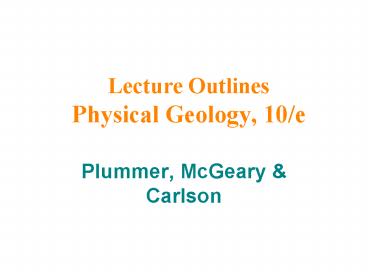Lecture Outlines Physical Geology, 10e - PowerPoint PPT Presentation
1 / 12
Title:
Lecture Outlines Physical Geology, 10e
Description:
Rocks exposed at Earth's surface are constantly changed by water, air, ... Freeze/thaw cycling mechanically weathers. Biosphere. Plant root growth widens cracks ... – PowerPoint PPT presentation
Number of Views:62
Avg rating:3.0/5.0
Title: Lecture Outlines Physical Geology, 10e
1
Lecture OutlinesPhysical Geology, 10/e
- Plummer, McGeary Carlson
2
Weathering and SoilPhysical Geology 10/e,
Chapter 5
Steve Kadel, Glendale Community College
3
Weathering, Erosion, and Transportation
- Rocks exposed at Earths surface are constantly
changed by water, air, temperature variations and
other factors - Weathering is the group of destructive processes
that change physical and chemical character of
rocks at or near Earths surface - Erosion is physical picking up of rock particles
by water, ice, or wind - Transportation is the movement of eroded
particles by water, ice, or wind
4
Weathering and Earth Systems
- Solar system
- Earth-style weathering (water, ice, wind) is
nearly unique to our planet, at present. Small
amounts of weathering (primarily by wind) still
occur on Mars, and water erosion appears to have
been important there in the distant past. - Atmosphere
- Oxygen and carbon dioxide critical to chemical
weathering - Water cycled through atmosphere is critical to
chemical and mechanical weathering processes - Air in soils contributes to biological action
that can produce chemical and mechanical
weathering
5
Weathering and Earth Systems
- Hydrosphere
- Water is necessary for chemical weathering
- Oxygen dissolved in water oxidizes iron in rocks
- Carbon dioxide dissolved in water creates
carbonic acid - Primary cause of chemical weathering
- Running water loosens and abrades particles
- Glacial ice removes and abrades particles
- Freeze/thaw cycling mechanically weathers
- Biosphere
- Plant root growth widens cracks
- Animal foot traffic and human activity
mechanically weather - Decaying organic matter in soils produces acidic
soil moisture
6
Types of Weathering
- Mechanical weathering
- Physical disintegration
- Frost action, pressure-release fracturing, plant
growth, burrowing animals, salt wedging, thermal
cycling - Chemical weathering
- Decomposition of rock from exposure to
atmospheric gases (oxygen, water vapor and carbon
dioxide) - New chemical compounds (minerals) form
- Rate increased by increased rock surface area
Spheroidal weathering
7
Mechanical Weathering
- Frost action
- Mechanic effect of freezing (and expanding) water
on rocks - Pressure release
- Removal of overlying rock allows expansion and
fracturing - Plant growth
- Growing roots widen fractures
- Burrowing animals
- Thermal cycling
- Large temperature changes fracture rocks by
repeated expansion and contraction
8
Chemical Weathering
- Oxidation
- Chemically active oxygen from atmosphere
- Iron oxides are common result
- Soil and sedimentary rocks often stained with
iron oxides - Acid dissolution
- Hydrogen cations replace others in minerals
- Carbonic acid from atmospheric CO2 dissolved in
water - Sulfuric, hydrofluoric acids emitted by volcanic
eruptions - Some minerals, such as calcite, may be totally
dissolved
9
Chemical Weathering
- Feldspars
- Most common minerals in crust
- Slightly acidic rain water attacks feldspar
- Clay minerals produced
- K, Na, Ca ions released into water
- Other minerals
- Ferromagnesian minerals
- Clays, iron oxides, Mg ions produced
- More complex silicate bonds lead to lower
weathering susceptibility - Olivine most susceptible, quartz least
- Warm, wet climatic conditions maximize weathering
10
Soil
- Soil - a layer of weathered, unconsolidated
material on top of bedrock - Common soil constituents
- Clay minerals
- Quartz
- Water
- Organic matter
- Soil horizons
- O horizon - uppermost layer organic material
- A horizon - dark layer rich in humus, organic
acids - E horizon - zone of leaching fine-grained
components removed by percolating water - B horizon - zone of accumulation clays and iron
oxides leached down from above - A horizon - partially weathered bedrock
11
Soils and Climate
- Soil thickness and composition are greatly
affected by climate - Wet climates
- More chemical weathering and thicker soils
- Soils in moderately wet climates tend to have
significant clay-rich layers, which may be solid
enough to form a hardpan - Arid climates
- Less chemical weathering and thinner soils
- Subsurface evaporation leads to build-up of salts
- Calcite-rich accumulation zones may form,
cementing soil together into a hardpan - Extremely wet climates (e.g., tropical
rainforest) - Highly leached and unproductive soils (laterites)
- Most nutrients come from thick O/A horizons
12
End of Chapter 5































